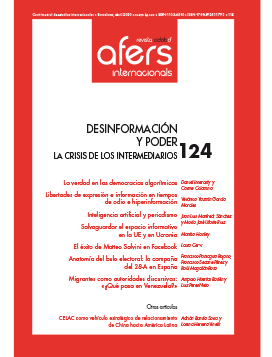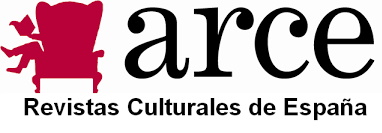Inteligencia artificial y periodismo: una herramienta contra la desinformación
Palabras clave:
periodismo, inteligencia artificial (IA), desinformación, propaganda, censura, ciudadaníaResumen
Revista CIDOB d’Afers Internacionals, nº 124
Cuatrimestral (enero-abril 2020)
ISSN:1133-6595 | E-ISSN:2013-035X
DOI: doi.org/10.24241/rcai.2020.124.1.49
Este trabajo investiga el impacto de la inteligencia artificial (IA) en el periodismo y en la desinformación. El diseño metodológico para alcanzar este propósito parte de la revisión de la literatura científica y se complementa con el análisis de tres perspectivas interrelacionadas: la periodística, la económica y la ética. Los resultados revelan que la desinformación es un fenómeno polisémico, lo que dificulta el diseño de una política pública para contrarrestarla. Sin embargo, la IA aparece como una oportunidad para contribuir a ello y desarrollar el concepto de ciudadanía, en tres ejes: 1) la mejora del estado del Periodismo profesional, 2) el manejo de la privacidad y 3) el planteamiento ético del desarrollo tecnológico, que contribuya a que las decisiones informativas sean conscientes y alejadas de los sesgos.
Citas
Bakshy, Eytan; Messing, Solomon y Adamic, Lada A. «Exposure to ideologically diverse news and opinion on Facebook». Science, vol. 348, n.° 6.239 (2015), p. 1.130-1.132.
Beer, David Gareth. «The Social Power of Algorithms. Information». Communication and Society, vol. 20, n.° 1 (2017), p. 1-13.
Benkler, Yochai; Faris, Robert y Roberts, Hal. Network Propaganda: Manipulation, Disinformation, and Radicalization in American Politics. Nueva York: Oxford University Press, 2018.
Bradshaw, Samantha y Howard, Philip N. «Troops, Trolls and Troublemakers: A Global Inventory of Organized Social Media Manipulation». Computational Propaganda Research Project, Working Paper n.° 2017.12, University of Oxford, 2017, p. 1-37.
Bucher, Taina. «“Machines don’t have instincts”: Articulating the computational in journalism». New Media & Society, vol. 19, n.° 6 (2017), p. 918-933.
Bullock, Joseph y Luengo-Oroz, Miguel. «Automated Speech Generation from UN General Assembly Statements: Mapping Risks in AI Generated Texts». International Conference on Machine Learning AI for Social Good Workshop, Long Beach, United States, 2019.
Campos-Domínguez, Eva. «Twitter y la comunicación política». El profesional de la información, vol. 26, n.° 5 (2017), p. 785-793.
Carlson, Matt. «The robotic reporter: Automated journalism and the redefinition of labor, compositional forms, and journalistic authority». Digital Journalism, vol. 3, n.° 3 (2015), p. 416-431.
Caswell, David y Dörr, Konstantin. «Automated Journalism 2.0: Event-driven narratives». Journalism Practice, vol. 12, n.° 4 (2018), p. 477-496.
Chesney, Robert y Citron, Danielle. «Deepfakes and the New Disinformation War. The Coming Age of Post-Truth Geopolitics». Foreign Affairs, vol. 98, n.° 1 (2019), p. 147-155.
Clerwall, Christer. «Enter the robot journalist». Journalism practice, vol. 8, n.° 5 (2014), p. 519-531 (en línea) [Fecha de consulta: 18.07.2019] https://doi.org/10.1080/17512786.2014.883116
Codina, Lluís. «Revisiones sistematizadas y cómo llevarlas a cabo con garantías: Systematic reviews y SALSA Framework». Lluiscodina blog, (20 de abril de 2017) (en línea) [Fecha de consulta: 09.11.2019] https://www.lluiscodina.com/revision-sistematica-salsa-framework/
Comisión Europea-High-Level Expert Group on Artificial Intelligence. A definition of Artificial Intelligence: Main Capabilities and Scientific Disciplines. Bruselas: European Commission, 2019.
Consejo de la Unión Europea. «Ciberseguridad en Europa: normas más estrictas y mejor protección». Consejo Europeo, (julio 2019) (en línea) [Fecha de consulta: 17.07.2019] https://www.consilium.europa.eu/es/policies/cyber-security/
Cornia, Alessio; Sehl, Annika y Nielsen, Rasmus Kleis. Private Sector Media and Digital News. Londres: Reuters Institute for the Study of Journalism/Digital Media Project, 2016.
Cortina, Adela. «Ciudadanía mediática». El País, (24 de noviembre de 2004) (en línea) [Fecha de consulta: 19.07.2019] https://elpais.com/diario/2004/11/24/opinion/1101250805_850215.html
Council of Europe. «Algorithms and human rights: Study on the human rights dimension of automated data processing techniques and possible regulatory implications». Council of Europe, (2018) (en línea) [Fecha de consulta: 15.07.2019] https://edoc.coe.int/en/internet/7589-algorithms-and-humanrights-study-on-the-human-rights-dimensions-of-automated-data-processing-techniques-and-possible-regulatory-implications.html
Darnton, Robert. «The True History of Fake News». New York Review of Books, (13 de febrero 2017) (en línea) [Fecha de consulta: 19.07.2019] http://www.nybooks.com/daily/2017/02/13/the-true-history-of-fakenews/
Del Fresno-García, Miguel. «Desórdenes informativos: sobreexpuestos e infrainformados en la era de la posverdad». El profesional de la información, vol. 28, n.° 3 (2019) (en línea) [Fecha de consulta: 19.07.2019] https://doi.org/10.3145/epi.2019.may.02
Del Fresno-García, Miguel y Manfredi-Sánchez, Juan Luis. «Politics, hackers and partisan networking. Misinformation, national utility and free election in the Catalan independence movement». El profesional de la información, vol. 27, n.° 6 (2018), p. 1.225-1.238 (en línea) [Fecha de consulta: 19.07.2019] https://doi.org/10.3145/epi.2018.nov.06
Drok, Nico y Hermans, Liesbeth. «Is there a future for slow journalism?» Journalism Practice, vol. 10, n.° 4 (2016), p. 539-554 (en línea) [Fecha de consulta: 12.07.2019] https://doi.org/10.1080/17512786.2015.1102604
Fernández Barbudo, Carlos «El nuevo concepto de privacidad: la transformación estructural de la visibilidad», Revista de Estudios Políticos, n.° 185 (2019), p. 139-167 (en línea) doi: https://doi.org/10.18042/cepc/rep.185.05
Kwan, Victoria. «Facebook’s ex-security chief on disinformation campaigns: ‘The sexiest explanation is usually not true». First Draft, (9 de julio de 2019) (en línea) [Fecha de consulta: 19.07.2019] https://firstdraftnews.org/alexstamos-interview-disinformation-campaigns/
Fletcher, Richard y Nielsen, Rasmus. «People don’t trust news media – and this is key to the global misinformation debate». nderstanding and Addressing the Disinformation Ecosystem. Annenberg School of Communication, 2017, pp.13-17.
Flores-Vivar, Jesús Miguel. «Algoritmos, aplicaciones y Big data, nuevos paradigmas en el proceso de comunicación y de enseñanza-aprendizaje del periodismo de datos». Revista de Comunicación, vol. 17, n.° 2 (2018), p. 268-291.
http://dx.doi.org/10.26441/RC17.2-2018-A12
Floridi, Luciano. «Artificial intelligence, deepfakes and a future of ectypes». Philosophy & Technology, vol. 31, n.° 3 (2018a), p. 317-321 (en línea) https://doi.org/10.1007/s13347-018-0325-3
Floridi, Luciano. «Semantic Capital: Its Nature, Value and Curation». Philosophy & Technology, vol. 31, n.° 4 (2018b), p. 481-497 (en línea) http://dx.doi.org/10.1007/s13347-018-0335-1
Franke, Ulrike y Sartori, Paola. «Machine politics: Europe and the AI revolution». European Council on Foreign Relations, (julio 2019) (en línea) [Fecha
de consulta: 17.07.2019] https://www.ecfr.eu/page/-/machine_politics_europe_and_the_ai_revolution.pdf
Gani, Aisha y Haddou, Leila. «Could robots be the journalists of the future?». The Guardian, (16 de marzo de 2014) (en línea) [Fecha de consulta: 09.11.2019] https://www.theguardian.com/media/shortcuts/2014/mar/16/could-robots-be-journalist-of-future
Graefe, Andreas. Guide to automated journalism. Nueva York: Tow Center for Digital Journalism, 2016 (en línea) [Fecha de consulta: 19.07.2019] https://legacy.gitbook.com/download/pdf/book/towcenter/guide-to-automatedjournalism
Green, Ben. «Data Science as Political Action: Grounding Data Science in a Politics of Justice». Working Paper, (2018) [Fecha de consulta: 11.07.2019] https://scholar.harvard.edu/files/bgreen/files/data_science_as_political_action.pdf
Haass, Richard. «How a World Order Ends and What Comes in Its Wake». Foreign Affairs, vol. 98, n.° 1 (2019), p. 22-30.
Hansen, Mark; Roca-Sales, Maritxell; Keegan, Jon y King, George. Artificial Intelligence: Practice and Implications for Journalism. Nueva York: Tow Center for Digital Journalism y Brown Institute for Media Innovacion, (2017) (en línea) [Fecha de consulta: 11.07.2019] https://doi.org/10.7916/D8X92PRD
Harcup, Tony y O’Neill, Deirdre. «What is News?». Journalism Studies, vol. 18, n.° 12 (2017), p. 1.470-1.488.
Hildebrandt, Mireille. «Who needs stories if you can get the data? ISPs in the era of big number crunching». Philosophy & Technology, vol. 24, n.° 4 (2011), p. 371-390 (en línea) [Fecha de consulta: 17.07.2019] https://link.springer.com/article/10.1007/s13347-011-0041-8
Jack, Caroline. «Lexicon of Lies. Terms for Problematic Information». Data & Society (8 de septiembre de 2017) (en línea) [Fecha de consulta: 11.07.2019] https://datasociety.net/pubs/oh/DataAndSociety_LexiconofLies.pdf
Karlsen, Joakim y Stavelin, Elrik. «Computational journalism in Norwegian newsrooms». Journalism practice, vol. 8, n.° 1 (2014), p. 34-48 (en línea) [Fecha de consulta: 13.07.2019] https://doi.org/10.1080/17512786.2013.813190
Kovach, Bill y Rosentiel, Tom. The elements of journalism. What newspeople should know and the public should expect. Nueva York: Three Rivers Press, 2007.
Krüger, Uwe. Mainstream. Warum wir den Medien nicht mehr trauen. Múnich: C.H. Beck, 2016.
Lemelshtrich Latar, Noam. Robot Journalism. Can Human Journalism Survive? Singapur: Centro Interdisciplinario Herzliya, 2018.
Lewis, Seth C. «What is journalism school for? A call for input». NiemanLab, (1 de febrero de 2010) (en línea) [Fecha de consulta: 16.07.2019] http://www.niemanlab.org/2010/02/what-is-journalism-school-for-a-call-for-input/
Lichterman, Joseph. «Want to bring automation to your newsroom? A new AP report details best practices». NiemanLab, (5 de abril de 2017) (en línea) [Fecha de consulta: 16.07.2019] http://www.niemanlab.org/2017/04/want-to-bringautomation-to-your-newsroom-a-new-ap-report-details-best-practices/
López de Mantarás, Ramón. «Ética en la inteligencia artificial». Investigación y Ciencia, n.°491 (2017), p. 49-49.
López-García, Guillermo y Pavía, José María. «Political communication in election processes: an overview». Contemporary Social Science, vol. 14, n.° 1 (2018) (en línea) [Fecha de consulta: 16.07.2019] https://doi.org/10.1080/21582041.2018.1479040
Magallón Rosa, Raúl: Unfaking News. Cómo combatir la desinformación. Madrid: Pirámide, 2019.
Manfredi-Sánchez, Juan Luis. «Horizontes de la información pública». El profesional de la información, vol. 26, n.° 3 (2017), p. 353-360 (en línea) [Fecha de consulta: 19.07.2019] https://doi.org/10.3145/epi.2017.may.01
Marconi, Francesco y Siegman, Alex. «The Future of Augmented Journalism: A guide for newsrooms in the age of smart machines». The Associated Press, 2017 (en línea) https://insights.ap.org/uploads/images/the-future-of-augmented-journalism_ap-report.pdf
Martín, Sean. «Rise of the machine: Journalists under threat as AI robot writes article in one second». Express, (23 de enero de 2017) [Fecha de consulta: 09.11.2019] https://www.express.co.uk/news/science/757802/RISE-OFTHE-MACHINE-artificial-intelligence-ai
Marwick, Alice y Lewis, Rebecca. «Media Manipulation and Disinformation Online». Data & Society, (15 de mayo de 2017) (en línea) [Fecha de consulta: 12.07.2019] https://datasociety.net/output/media-manipulation-and-disinfo-online/
Matthias, Andreas. «The responsibility gap: Ascribing responsibility for the actions of learning automata». Ethics and Information Technology, vol. 6, n.° 3 (2004), p. 175-183.
Mele, Nicco. «Necesitamos algoritmos que privilegien la calidad». Agenda Pública El País, (10 de julio de 2019) (en línea) [Fecha de consulta: 10.07.2019] http://agendapublica.elpais.com/necesitamos-algoritmosque-privilegien-la-calidad/
Monnerat, Alessandra. «Científicos de datos trabajan en el primer robot-periodista de Brasil para reportar sobre proyectos de ley de la Cámara». Journalism in the Americas (13 de enero de 2018) (en línea) [Fecha de consulta: 09.11.2019] https://knightcenter.utexas.edu/es/blog/00-19184-cientificosde-datos-trabajan-en-el-primer-robot-periodista-de-brasil-para-reportar-so
Napoli, Phillip. «Audience evolution and the future of audience research». International journal on media management, vol. 14, n.° 2 (2012), p. 79-97 (en línea) [Fecha de consulta: 04.07.2019] https://doi.org/10.1080/14241277.2012.675753
Newman, Nic. Journalism, media and technology trends and predictions 2019. Oxford: Reuters Institute for the Study of Journalism, 2019 (en línea) [Fecha de consulta: 17.07.2019] https://reutersinstitute.politics.ox.ac.uk/ourresearch/journalism-media-and-technology-trends-and-predictions-2019
Nichols, Tom. The Death of Expertise: The Campaign Against Established Knowledge and Why It Matters. Oxford: Oxford University Press, 2017.
Pariser, Eli. The Filter Bubble: What the Internet is Hiding from You. Londres:
Viking, 2011.
Parlamento Europeo (2017). Resolución del Parlamento Europeo, de 16 de febrero de 2017, con recomendaciones destinadas a la Comisión sobre normas de Derecho civil sobre robótica (2015/2103(INL)) (en línea) [Fecha de consulta: 10.02.2019] http://www.europarl.europa.eu/doceo/document/TA-8-2017-0051_ES.pdf
Pasquale, Frank. The Black Box Society. Cambridge: Harvard University Press, 2015.
Patterson, Thomas E. Informing the News: The Need for Knowledge-Based Journalism. Nueva York: Vintage Books, 2013.
Posetti, Julie. Time to step away from the ‘bright, shiny things’? Towards a sustainable model of journalism innovation in an era of perpetual change. Oxford: Reuters Institute for de Study of Journalism, 2018 (en línea) [Fecha de consulta: 17.07.2019]
Ramírez-Montoya, María Soledad y García-Peñalvo, Francisco José. «Co-creación e innovación abierta: Revisión sistemática de literatura». Comunicar, vol.26, n.° 54 (2018), p. 9-18 (en línea) https://doi.org/10.3916/C54-2018-01
Raymond, Mark y DeNardis, Laura. «Multistakeholderism: anatomy of an inchoate global institution». International Theory, vol. 7, n.° 3 (2015), p. 572-616 (en línea) [Fecha de consulta: 13.07.2019] https://doi.org/10.1017/S1752971915000081
Ruppert, Evelyn; Isin, Engin y Bigo, Didier. «Data politics». Big Data & Society, (2017), p. 1-7 (en línea) [Fecha de consulta: 19.07.2019] https://doi.org/10.1177/2053951717717749
Salaverría, Ramón. «Periodismo en 2014: balance y tendencia». Cuaderno de Periodistas, n.° 29 (2014), p. 9-22.
Salazar, Idoia. «Los robots y la Inteligencia Artificial. Nuevos retos del periodismo». Doxa Comunicación, n.° 27 (2018), p. 295-315.
Stroud, Natalie Jomini; Thorson, Emily y Young, Dannagal. «Making sense of information and judging its credibility». Understanding and Addressing the Disinformation Ecosystem. Annenberg School of Communication, 2017, p.45-50.
Tandoc Jr, Edson C.; Lim, Zheng W. y Ling, Richard. «Defining “fake news” A typology of scholarly definitions». Digital journalism, vol. 6, n.° 2 (2018), p. 137-153.
Toscano, Manuel. «Sobre el concepto de privacidad: la relación entre privacidad e intimidad». Isegoría Revista de Filosofía Moral y Política, n.° 57 (2017), p.533-552.
Túñez López, José Miguel; Parada Pacheco, Patricia y Toural Bran, Carlos. «Redacción automatizada y su impacto en la elaboración de noticias. Estudio comparativo de textos informativos elaborados por robots y por humanos». xxv Congreso Internacional SEP Oportunidades y riesgos del periodismo hiperconectado, (30-31 de mayo de 2019), Bizkaia Aretoa (Bilbao, UPV/EHU).
Túñez López, José Miguel y Toural Bran, Carlos. «Inteligencia Artificial en la gestión de la comunicación: impacto de la robotización en la elaboración de contenidos informativos». En: Comunicación y Música: mensajes, manifestaciones y negocios. VV. AA. Cuadernos Artesanos de Comunicación, n.° 145. La Laguna (Tenerife): Latina, 2018, p. 1.884-1.896.
Túñez López, José-Miguel; Toural Bran, Carlos y Cacheiro Requeijo, Santiago. «Uso de bots y algoritmos para automatizar la redacción de noticias: percepción y actitudes de los periodistas en España». El profesional de la información, vol. 27, n.° 4 (2018), p. 750-758.
Ufarte Ruiz, María José y Manfredi-Sánchez, Juan-Luis. «Algoritmos y bots aplicados al periodismo. El caso de Narrativa Inteligencia Artificial: estructura, producción y calidad informativa». Doxa Comunicación, vol. 29, (2019) pre-print
Ünver, Hamid Akin. «Computational Diplomacy. Cyber Governance and Digital Democracy». Edam, Centre for Economics and Foreign Policy Study, (2017) (en línea) [Fecha de consulta: 19.07.2019] http://edam.org.tr/wp-content/uploads/2017/11/bilisimsel_diplomasi_EN.pdf
Vállez, Mari y Codina, Lluís. «Periodismo computacional: evolución, casos y herramientas». El profesional de la información, vol. 27, n.° 4 (2018), p. 1.699-1.2407 (en línea) [Fecha de consulta: 16.07.2019] https://doi.org/10.3145/epi.2018.jul.05
Van Dalen, Arjen. «The algorithms behind the headlines». Journalism practice, vol. 6, n.° 5-6 (2012), p. 648-658 (en línea) [Fecha de consulta: 14.07.2019] https://doi.org/10.1080/17512786.2012.667268
Vosoughi, Soroush; Roy, Deb y Aral, Sinan. «The spread of true and false news online». Science, vol. 359, n.° 6380 (2018), p. 1.146-1.151 (en línea) [Fecha de consulta: 11.07.2019] https://doi.org/10.1126/science.aap9559
Wardle, Claire y Derakhshan, Hossein. «Information Disorder: Toward an Interdisciplinary Framework for Research and Policy Making». Informe al Consejo de Europa, (2017) (en línea) [Fecha de consulta: 14.07.2019] https://shorensteincenter.org/information-disorder-framework-for-research-andpolicymaking/Whittaker, Jason Paul. Tech Giants, Artificial Intelligence, and the Future of Journalism. Nueva York: Routledge, 2018.












